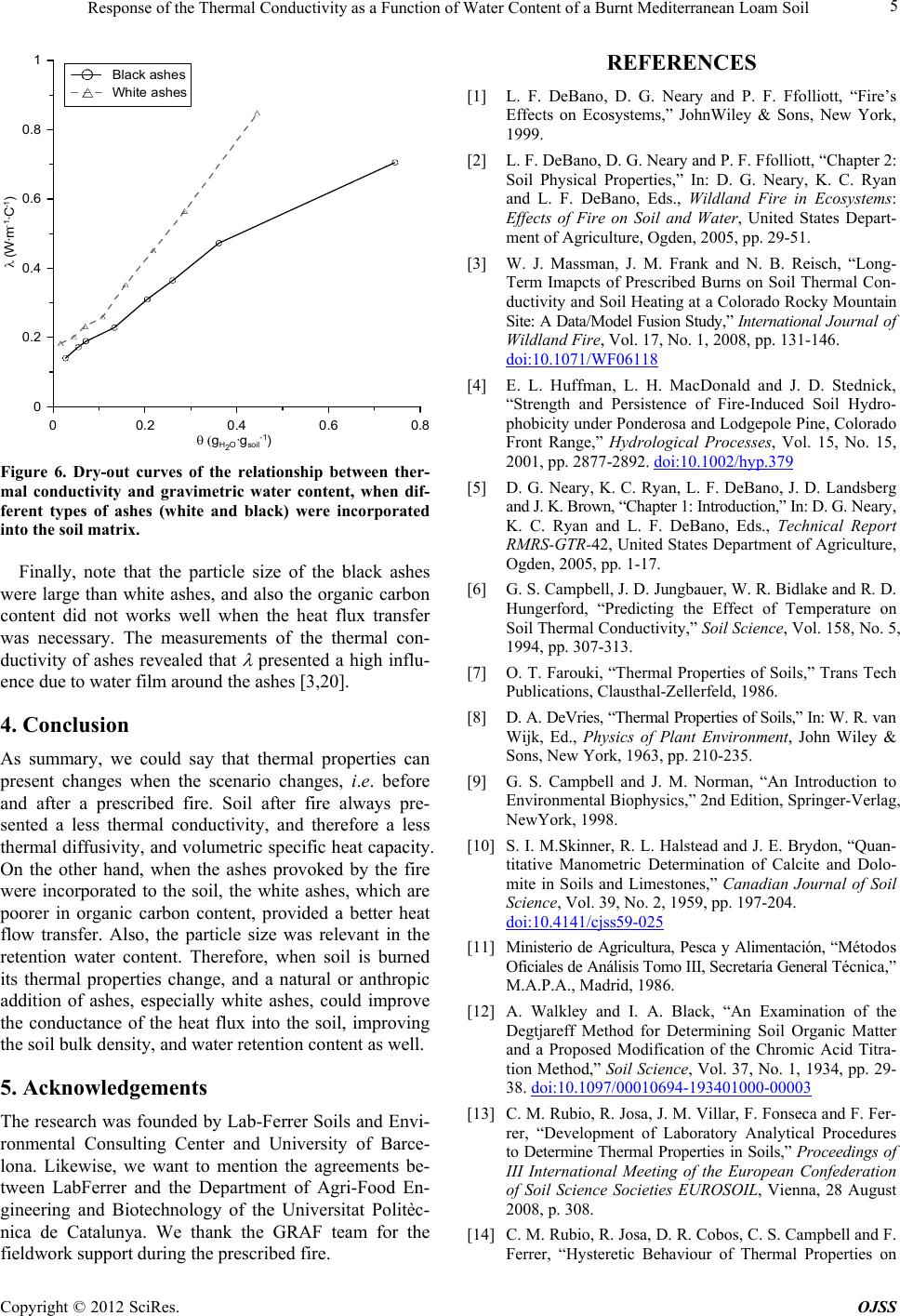
Response of the Thermal Conductivity as a Function of Water Content of a Burnt Mediterranean Loam Soil 5
00.20.40.6
g
H2O
·g
soi l-1
)0.8
0
0.2
0.4
0.6
0.8
1
(W·m
-1
·C
-1
)
Black ashes
White ashes
Figure 6. Dry-out curves of the relationship between ther-
mal conductivity and gravimetric water content, when dif-
ferent types of ashes (white and black) were incorporated
into the soil matrix.
Finally, note that the particle size of the black ashes
were large than white ashes, and also the organic carbon
content did not works well when the heat flux transfer
was necessary. The measurements of the thermal con-
ductivity of ashes revealed that
presented a high influ-
ence due to water film around the ashes [3,20].
4. Conclusion
As summary, we could say that thermal properties can
present changes when the scenario changes, i.e. before
and after a prescribed fire. Soil after fire always pre-
sented a less thermal conductivity, and therefore a less
thermal diffusivity, and volumetric specific h eat capacity.
On the other hand, when the ashes provoked by the fire
were incorporated to the soil, the white ashes, which are
poorer in organic carbon content, provided a better heat
flow transfer. Also, the particle size was relevant in the
retention water content. Therefore, when soil is burned
its thermal properties change, and a natural or anthropic
addition of ashes, especially white ashes, could improve
the conductance of the heat flux into the soil, improving
the soil bulk density, and water retention content as well.
5. Acknowledgements
The research was founded by Lab-Ferrer Soils and Envi-
ronmental Consulting Center and University of Barce-
lona. Likewise, we want to mention the agreements be-
tween LabFerrer and the Department of Agri-Food En-
gineering and Biotechnology of the Universitat Politèc-
nica de Catalunya. We thank the GRAF team for the
fieldwork support during the prescribed fire.
REFERENCES
[1] L. F. DeBano, D. G. Neary and P. F. Ffolliott, “Fire’s
Effects on Ecosystems,” JohnWiley & Sons, New York,
1999.
[2] L. F. DeBano, D. G. Neary and P. F. Ffolliott, “Chapter 2:
Soil Physical Properties,” In: D. G. Neary, K. C. Ryan
and L. F. DeBano, Eds., Wildland Fire in Ecosystems:
Effects of Fire on Soil and Water, United States Depart-
ment of Agriculture, Ogden, 2005, pp. 29-51.
[3] W. J. Massman, J. M. Frank and N. B. Reisch, “Long-
Term Imapcts of Prescribed Burns on Soil Thermal Con-
ductivity and Soil Heating at a Colorado Rocky Mountain
Site: A Data/Model Fusi on Study,” International Journal of
Wildland Fire, Vol. 17, No. 1, 2008, pp. 131-146.
doi:10.1071/WF06118
[4] E. L. Huffman, L. H. MacDonald and J. D. Stednick,
“Strength and Persistence of Fire-Induced Soil Hydro-
phobicity under Ponderosa and Lodgepole Pine, Colorado
Front Range,” Hydrological Processes, Vol. 15, No. 15,
2001, pp. 2877-2892. doi:10.1002/hyp.379
[5] D. G. Neary, K. C. Ryan, L. F. DeBano, J. D. Landsberg
and J. K. Brown, “Chapter 1: Introduction,” In: D. G. Neary,
K. C. Ryan and L. F. DeBano, Eds., Technical Report
RMRS-GTR-42, United States Department of Agriculture,
Ogden, 2005, pp. 1-17.
[6] G. S. Campbell, J. D. Jungbauer, W. R. Bidlake and R. D.
Hungerford, “Predicting the Effect of Temperature on
Soil Thermal Conductivity,” Soil Science, Vol. 158, No. 5,
1994, pp. 307-313.
[7] O. T. Farouki, “Thermal Properties of Soils,” Trans Tech
Publications, Clausthal-Zellerfeld, 1986.
[8] D. A. DeVries, “T hermal Properties of Soil s,” In: W. R. va n
Wijk, Ed., Physics of Plant Environment, John Wiley &
Sons, New York, 1963, pp. 210-235.
[9] G. S. Campbell and J. M. Norman, “An Introduction to
Environmental Biophysics,” 2nd Edition, Springer-Verlag,
NewYork, 1998.
[10] S. I. M.Skinner, R. L. Halstead and J. E. Brydon, “Quan-
titative Manometric Determination of Calcite and Dolo-
mite in Soils and Limestones,” Canadian Journal of Soil
Science, Vol. 39, No. 2, 1959, pp. 197-204.
doi:10.4141/cjss59-025
[11] Ministerio de Agricultura, Pesca y Alimentación, “Métodos
Oficiales de Análisi s Tomo III, Secretaría Gene ral T éc n ica ,”
M.A.P.A., Madrid, 1986.
[12] A. Walkley and I. A. Black, “An Examination of the
Degtjareff Method for Determining Soil Organic Matter
and a Proposed Modification of the Chromic Acid Titra-
tion Method,” Soil Science, Vol. 37, No. 1, 1934, pp. 29-
38. doi:10.1097/00010694-193401000-00003
[13] C. M. Rubio, R. Josa, J. M. Villar, F. Fonseca and F. Fer-
rer, “Development of Laboratory Analytical Procedures
to Determine Thermal Properties in Soils,” Proceedings of
III International Meeting of the European Confederation
of Soil Science Societies EUROSOIL, Vienna, 28 August
2008, p. 308.
[14] C. M. Rubio, R. Josa, D. R. Cobos, C. S. Campbell and F.
Ferrer, “Hysteretic Behaviour of Thermal Properties on
Copyright © 2012 SciRes. OJSS